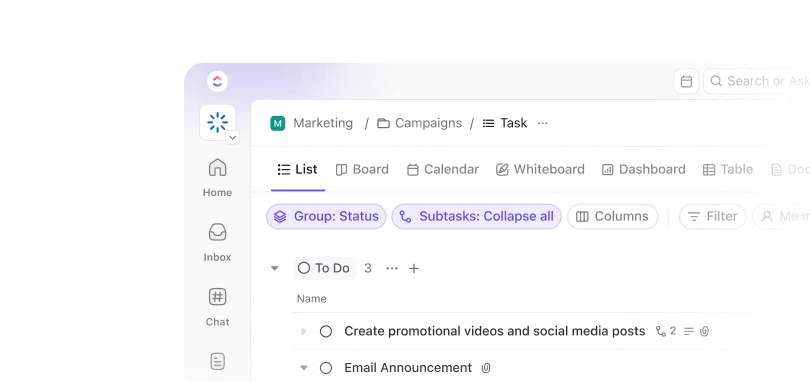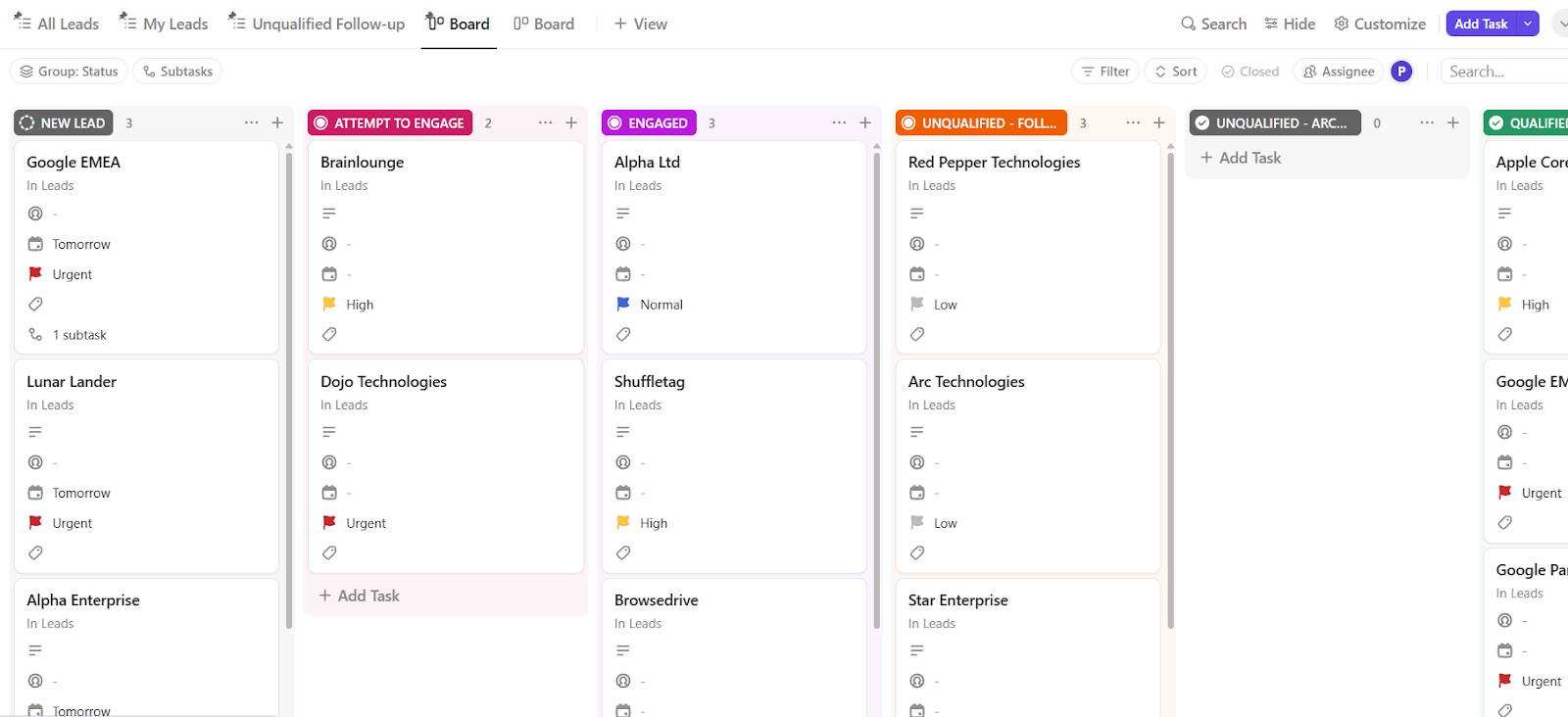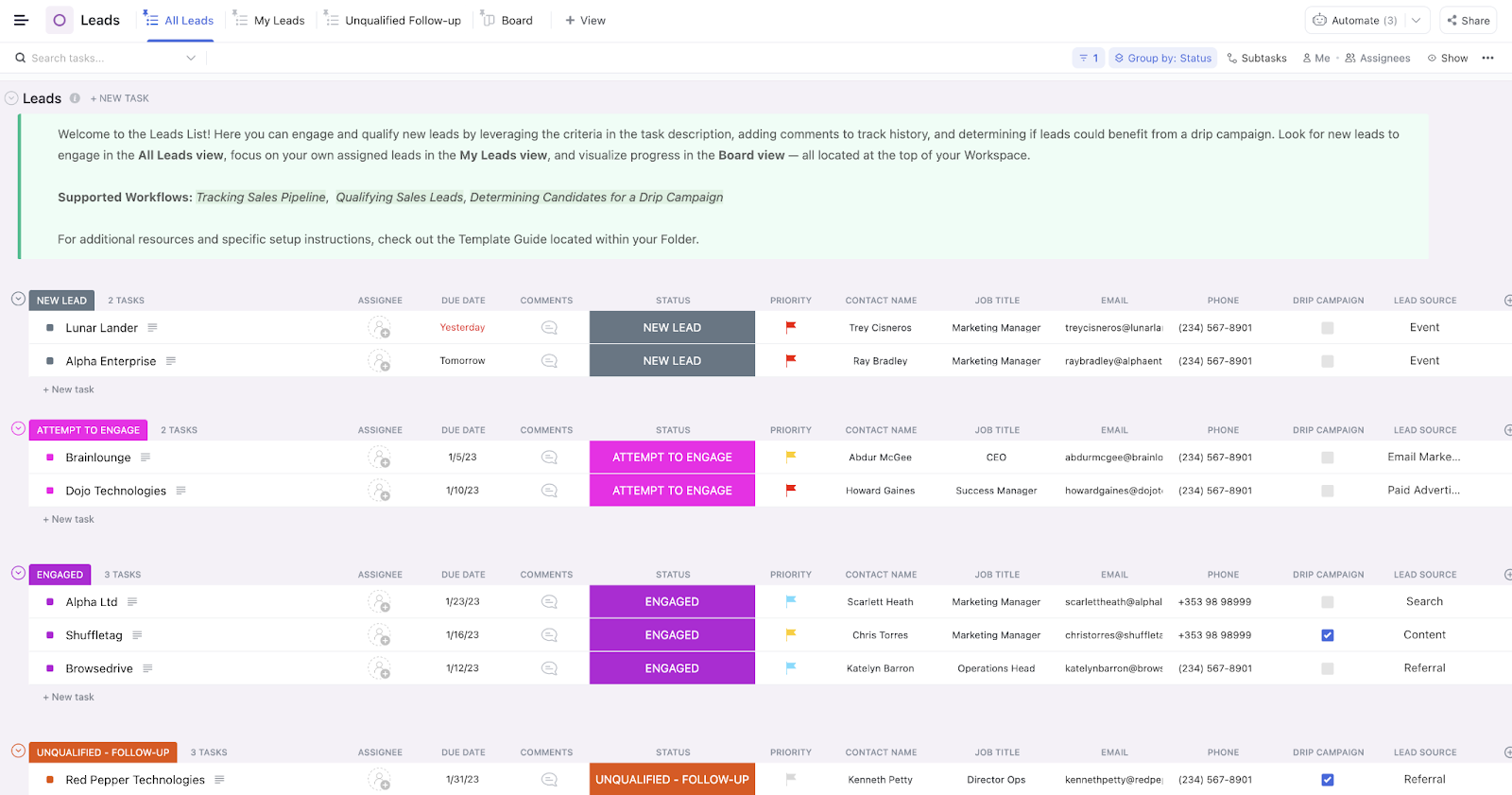When you’re scaling fast, the last thing you need is a customer relationship management (CRM) system that doesn’t talk to your invoicing system.
Disconnected tools mean slower sales cycles, scattered customer data, and billing errors that cost money and trust.
This blog post explores eight CRM and invoicing software tools built to grow with your business.
Let’s find the right tool for you! 🧾
- Top CRM and Invoicing Software at a Glance
- What Should You Look for In CRM and Invoicing Software?
- The Best CRM and Invoicing Software
- 1. ClickUp (Best for all-in-one project management, CRM, and billing)
- 2. Zoho CRM with Zoho Invoice (Best for automating client relationships with built-in billing)
- 3. Flowlu (Best for task planning, sales management, and finance tracking)
- 4. Pipedrive (Best for pipeline management, client follow-ups, and invoice generation)
- 5. FreshBooks (Best for time tracking, expense logging, and invoicing)
- 6. HubSpot (Best for CRM automation, quote creation, and revenue reporting)
- 7. Bitrix24 (Best for sales tracking and payment collection)
- 8. Odoo CRM (Best for workflow customization and customer management)
Top CRM and Invoicing Software at a Glance
Here’s a table comparing all CRM and invoicing software. 📊
| Tool | Best features | Best for | Pricing |
| ClickUp | Unified task + client management, AI-powered Docs and Automations, custom invoice workflows | All-in-one project, CRM, and billing workspace with integrated AI assistance | Free forever; customizations available for enterprises |
| Zoho CRM and Zoho Invoice | CRM-integrated invoicing, payment reminders, customer portals | Automating client relationships with built-in billing | Free trial; starts at $20/month per user |
| Flowlu | Customer relationship management with built-in invoicing and estimate tools, automation for recurring payments | Task planning, sales management, and payment tracking | Free plan available; starts at $49/month per user |
| Pipedrive | Deal-driven CRM, smart invoice creation from deals, integration capabilities with billing platforms | Pipeline management, client follow-ups, and invoicing capabilities | Free trial; starts at $24/month per user |
| FreshBooks | Easy invoicing with time tracking, expense capture, and late fee automation | Time tracking, expense logging, and invoicing | Free trial; starts at $21/month per user |
| HubSpot | Smart contact management, quote-to-cash tools, and Stripe/QuickBooks integrations for paid plans | CRM automation, quote creation, and revenue reporting | Free plan available; starts at $15/month per user |
| Bitrix24 | CRM software with task tracking, client portal, telephony, and e-signature options | Team collaboration, sales tracking, and payment collection | Free plan, starts at $124/month for 50 users |
| Odoo CRM | Modular CRM with invoicing/quoting apps, pipeline automation, lead tracking | Workflow customization and customer management | Free plan available; starts at $31.10/month per user |
How we review software at ClickUp
Our editorial team follows a transparent, research-backed, and vendor-neutral process, so you can trust that our recommendations are based on real product value.
Here’s a detailed rundown of how we review software at ClickUp.
What Should You Look for In CRM and Invoicing Software?
Wondering how to choose a CRM and invoicing software?
Start by identifying where your current sales process breaks down, whether it’s scattered client data, missed follow-ups, or delayed payments. Here are some additional features to prioritize:
- Customizable pipelines and statuses: Look for CRM solutions that let you tailor sales stages, deal statuses, and lead workflows to match your business process
- Automated invoicing and reminders: Choose tools that support recurring billing, automated invoice generation, and payment follow-up notifications to reduce manual work
- Centralized client communication: Seek platforms that integrate with email or chat so all client conversations are stored and searchable within your workspace
- Real-time reporting and dashboards: Consider systems that offer visual dashboards to track revenue, payment status, and sales performance at a glance
- Integration with finance tools: Ensure the software connects easily with apps like QuickBooks, Stripe, or Harvest to streamline financial operations
The Best CRM and Invoicing Software
These are our picks for the best CRM and invoicing software. 👇
1. ClickUp (Best for all-in-one project management, CRM, and billing)
ClickUp gives you one connected workspace to handle leads, track client work, and manage payments.
Build your pipeline using ClickUp CRM
Start with ClickUp CRM, which turns client tracking into something that actually fits your process. You can log every inquiry or deal using ClickUp Tasks, then attach related files, tag teammates, and note key updates as the conversation evolves.
Say you get a request from a retail client for a full rebrand. You create a task, add the discovery call notes, tag your design lead, and drop in the initial moodboard—all in the same place.
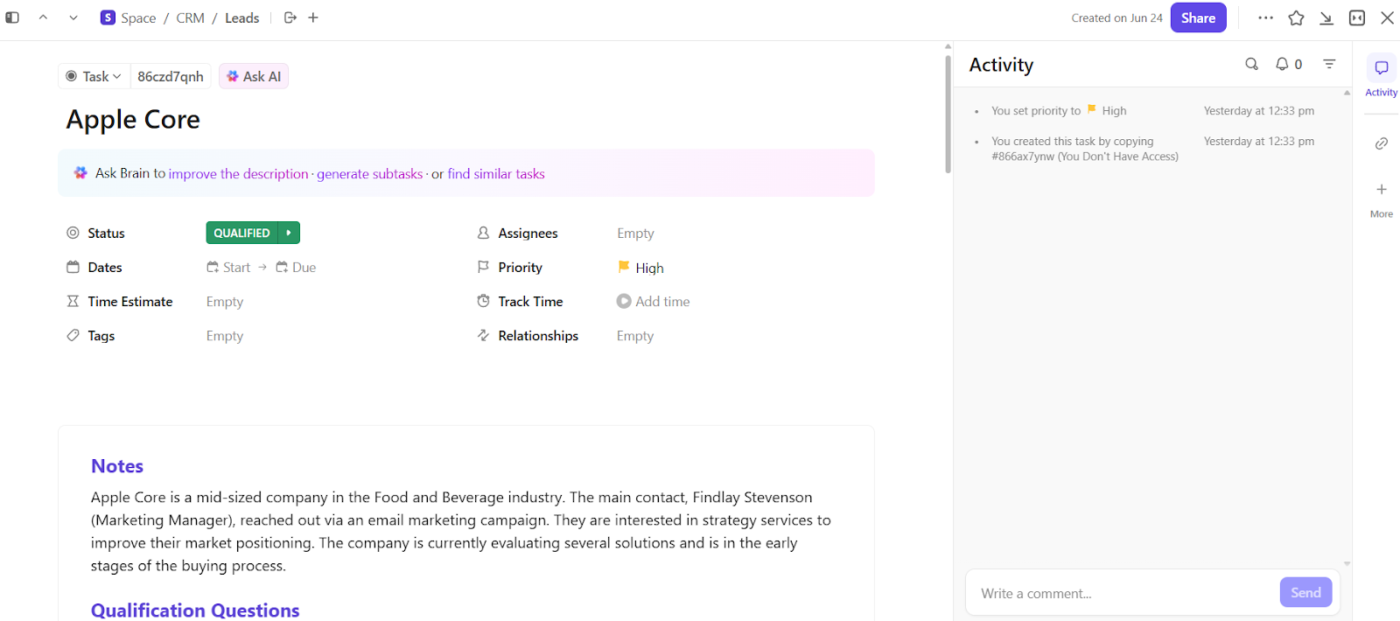
As the lead progresses, you update its stage using ClickUp Custom Task Statuses, such as ‘Proposal sent’, ‘Waiting for revisions’, or ‘Pending invoice’, so it’s always clear what’s in motion and what needs a nudge.
Then, layer in ClickUp Custom Fields to store project details like payment terms, client email, or estimated value. That way, when you need to sort high-value clients or check who’s due for payment, you already have the info where you’re working.
Use a ready-made CRM system
You can skip the setup, too.
ClickUp’s CRM Template helps segment leads by sales stage using Custom Statuses, such as Need Approval, Qualified, or Scheduled. The built-in Custom Fields, like CRM Item Type, Industry, Contact Name, or Job Title, allow you to build context-rich profiles.
Here, ClickUp’s List View helps sort leads by value, due date, or contract status.
Automate repetitive client handoffs
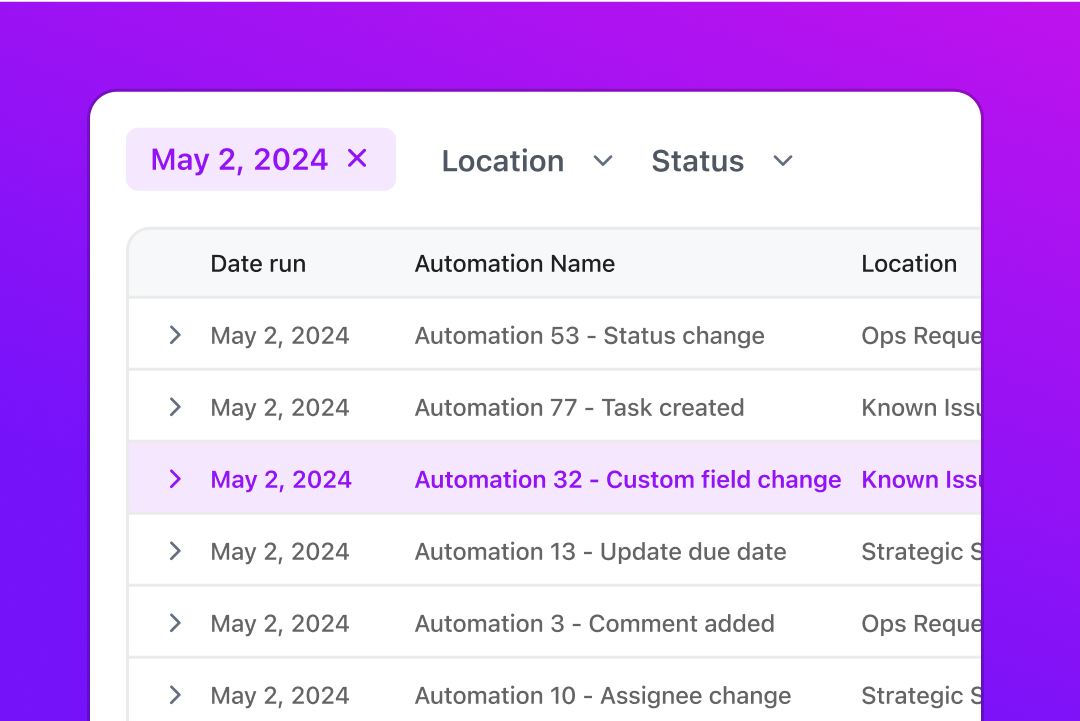
To avoid losing time on repetitive follow-ups, set up ClickUp Automations or configure an AI Agent in ClickUp. For example, when you mark a client as ‘Ready to invoice’, ClickUp can automatically create a billing task, tag your finance tool, and set a due date. You don’t need to remind yourself to do it later.
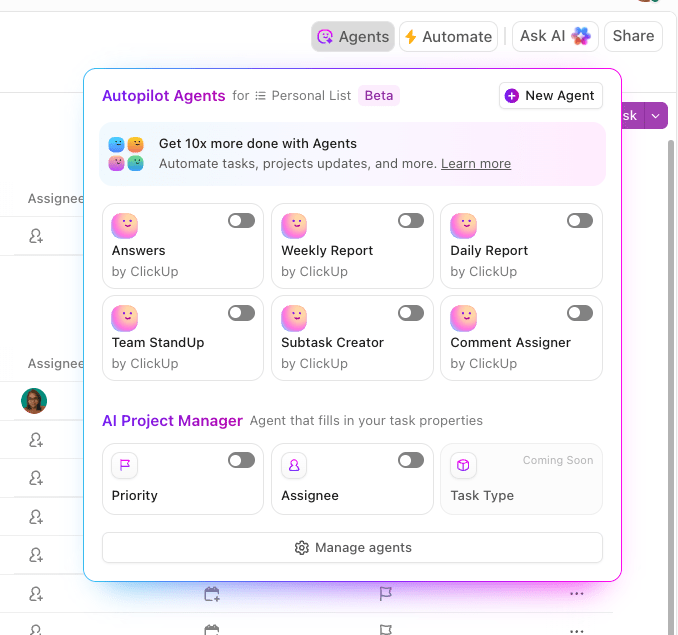
Monitor payments and client health
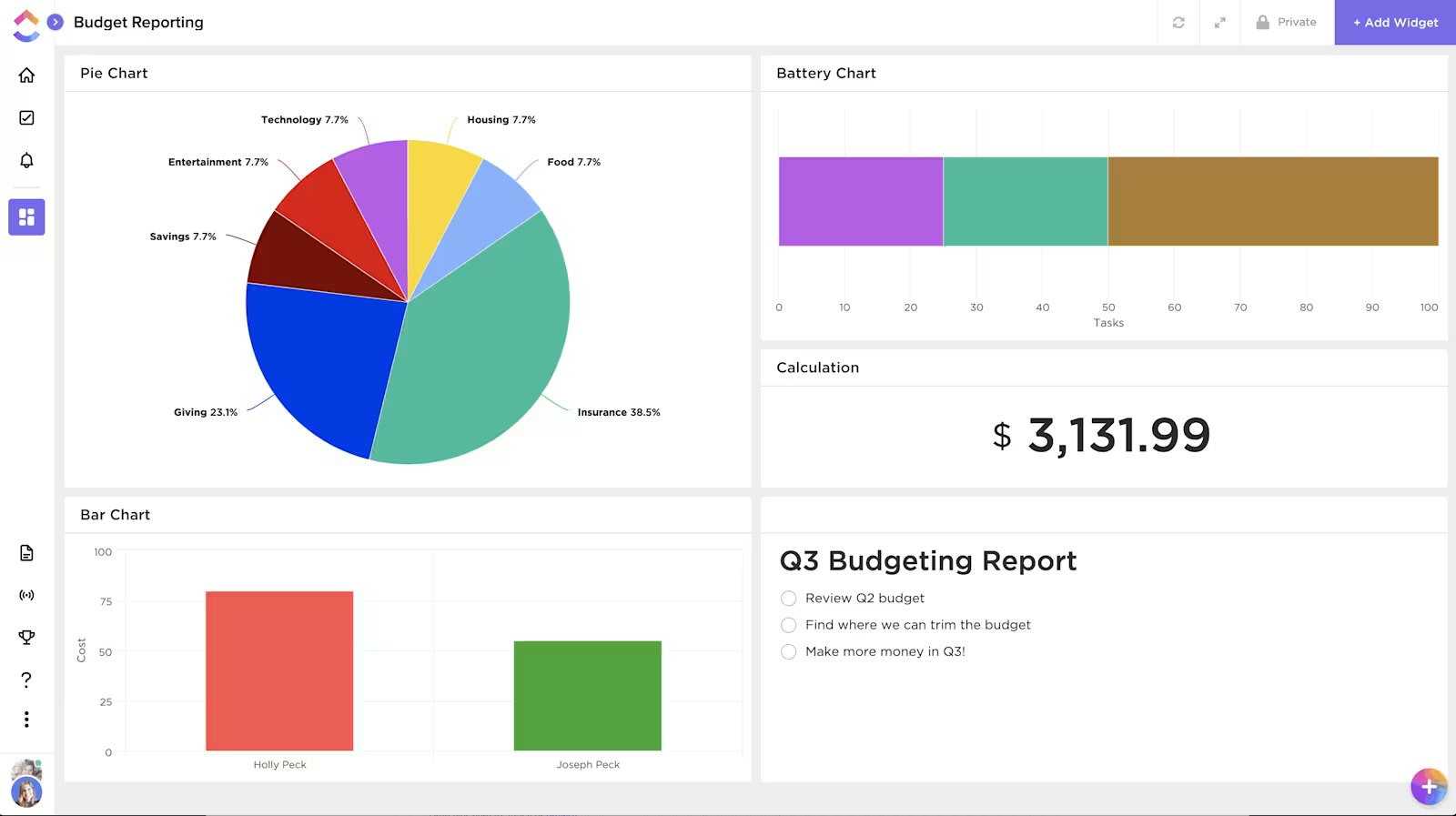
When you’re ready to invoice, ClickUp’s Finance Software helps you track payments, budgets, and project profitability inside the same workspace.
Let’s say you’re juggling three clients across branding, social media, and consulting. You can see who’s paid, who’s overdue, and what each project is worth in ClickUp Dashboards.
It’s also easy to track client management metrics, such as average deal size, close rate, client health score, or sales representative performance, using over 50 cards, including charts, calculation cards, and time tracking blocks.
Surface invoice insights instantly
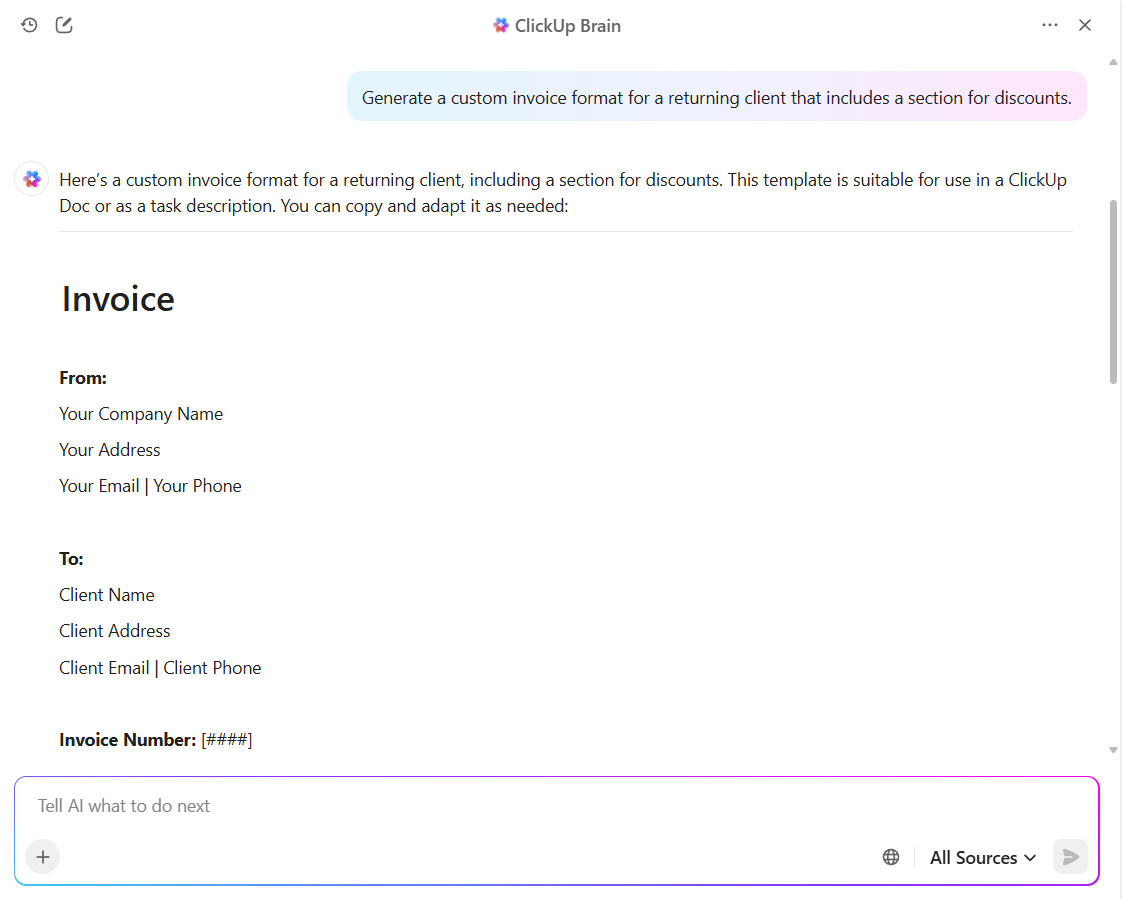
ClickUp Brain adds an intelligent layer to your CRM and finance workflows by surfacing key insights, creating invoices from scratch, and more, exactly when you need them.
For example, if you’re preparing a new invoice for a returning client, you can simply ask ClickUp Brain to generate a custom invoice format based on your past entries. It reviews your existing templates, client preferences, and payment details to create a ready-to-use layout that fits your project type and billing cycle.
Simplify your invoicing process
ClickUp also connects to tools like QuickBooks and Harvest via ClickUp Integrations, so when it’s time to send an invoice, you can pull all your project data straight in.
Alternatively, you can keep everything within ClickUp. Use the ClickUp Invoice Template to create a task for each invoice, set due dates, track payment status, and link everything back to the original client task. It works great when you’re keeping it simple and need a reliable system to stay on top of things.
If you’re tracking multiple payments across different clients, the ClickUp Invoice Tracking Template helps you log and filter them. And if you’re sending out quotes often, ClickUp’s Request for Quote Template helps you speed that up with consistency.
ClickUp best features
- Organize client knowledge: Link onboarding plans, service outlines, or SOWs created in ClickUp Docs directly to your Tasks so you never lose track of key information
- Gather client details: Create ClickUp Forms to collect quote requests and convert them instantly into trackable tasks in your workflow
- Quickly access workspace data: Ask ClickUp Brain questions like ‘show me outstanding invoices for Client X’ or ‘what’s the renewal date for that retainer?’ and get answers instantly
- Crunch numbers effortlessly: Use dynamic Formula Fields in ClickUp to automatically calculate deal size, cost to close, or projected revenue
- Collaborate with clients and sales professionals: Message inside your workspace using ClickUp Chat and hold SyncUp calls with AI-generated summaries
- Automate follow-ups and billing reminders: Activate ClickUp Autopilot Agents in your Chats, Lists, or Spaces to post weekly updates and answer client questions
ClickUp limitations
- Due to its extensive feature set, ClickUp can have a learning curve for new users as they get familiar with the platform’s depth and flexibility
ClickUp pricing
ClickUp ratings and reviews
- G2: 4.7/5 (10,000+ reviews)
- Capterra: 4.6/5 (4,000+ reviews)
What are real-life users saying about ClickUp?
This G2 review really says it all:
2. Zoho CRM with Zoho Invoice (Best for automating client relationships with built-in billing)
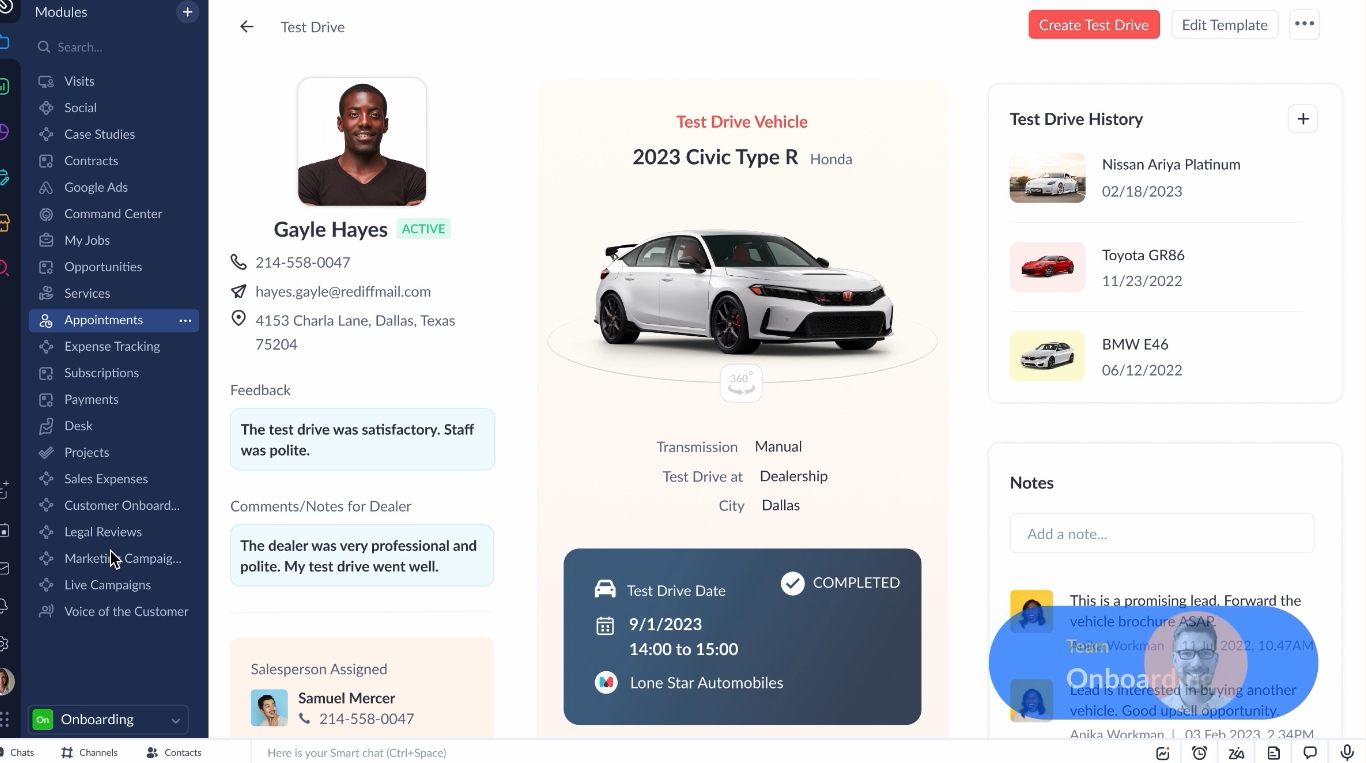
Zoho CRM and Zoho Invoice work hand-in-hand to manage financial and CRM workflows.
When sales closes a deal once a quote is approved, invoices are automatically generated, which cuts out the manual step of recreating customer information in your billing system. When a contact is added in Zoho CRM, the flow makes a copy of the details in Zoho Invoice, helping you create invoices and estimates more quickly.
The CRM software also features Zia, an AI-powered assistant that takes care of repetitive sales tasks, provides performance insights, and even suggests next steps based on customer behavior.
Zoho CRM and Zoho Invoice best features
- Score and sort leads with Zoho CRM’s intelligent lead scoring system that helps you identify high-intent prospects at a glance
- Create structured sales workflows using the Blueprint feature to map out deal stages, follow-ups, and approvals
- Assign leads automatically with assignment rules that route prospects based on location, channel, or engagement
- Design and send quotes fast with commercial invoice templates and instant quote-to-invoice conversion
Zoho CRM and Zoho Invoice limitations
- Missing or limited invoicing features in lower-tier plans, including usage caps and storage constraints
- Complex CRM reporting across multiple modules, making cross-functional insights difficult to extract
Zoho CRM and Zoho Invoice pricing
Zoho CRM
- Free trial
- Free (for three users)
- Standard: $20/month per user
- Professional: $35/month per user
- Enterprise: $50/month per user
- Ultimate: $65/month per user
Zoho Invoice: Free
Zoho CRM and Zoho Invoice ratings and reviews
- G2: 4.4/5 (50,000+ reviews)
- Capterra: 4.7/5 (800+ reviews)
What are real-life users saying about Zoho CRM and Zoho Invoice?
Look at this G2 review for the CRM and invoicing software:
🔍 Did You Know? Franklin D. Roosevelt had what some call the world’s first CRM system: the Farley File. His campaign manager, James Farley, kept detailed notes on everyone FDR met. FDR would casually bring up these details in later meetings, leaving people convinced he had a photographic memory. In reality, he just had great file management.
3. Flowlu (Best for task planning, sales management, and finance tracking)
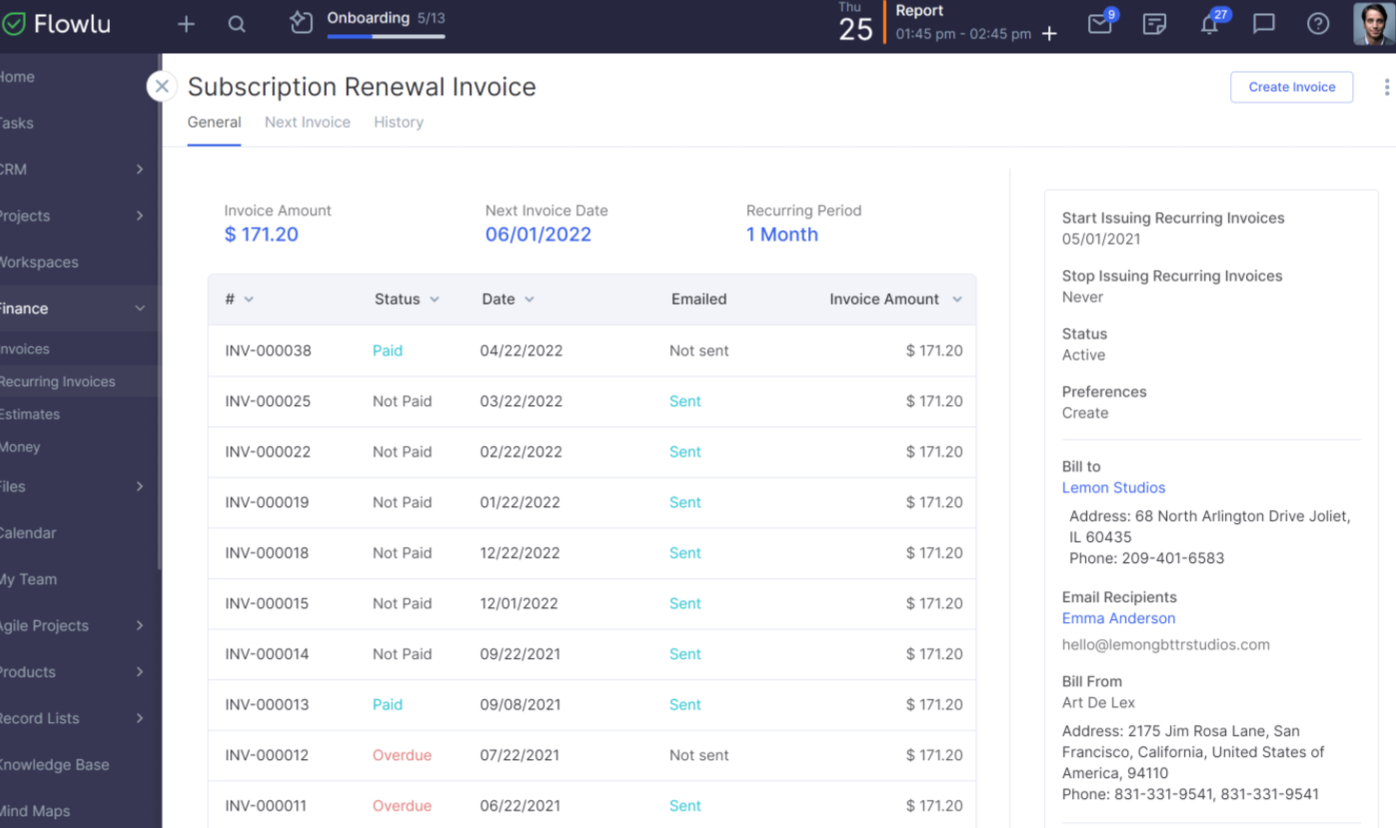
Flowlu works well when your billing ties directly to project deliverables.
The platform uses a cloud-based system to generate invoices from anywhere and bill clients worldwide, pulling customer information automatically from your customer database software. You can automate recurring invoice generation for ongoing services, saving you from manually creating the same invoices every month.
There’s a client portal in Flowlu where customers can access project updates, invoices, and files in one dedicated space, plus they can chat with your team through the built-in messenger. The system handles shipping and taxation calculations for all regions, which is particularly helpful when working with international clients.
Flowlu best features
- Build multiple sales pipelines to tailor deal flows for different markets, products, or customer types
- Auto-capture leads from emails using dedicated inboxes that instantly convert sales emails into CRM entries
- Get paid faster online using popular payment gateways and auto-record incoming payments for accurate tracking
- Convert estimates to invoices instantly once approved, eliminating delays between quoting and billing
Flowlu limitations
- Core functions like proposals or recurring payments are absent
- Defaults back to Kanban view, losing user preference settings
Flowlu pricing
- Free
- Essential: $12/month per user
- Advanced: $22/month per user
- Ultimate: Custom pricing
Flowlu ratings and reviews
- G2: 4.7/5 (150+ reviews)
- Capterra: 4.8/5 (300+ reviews)
What are real-life users saying about Flowlu?
A G2 reviewer summed it up like this:
💡 Pro Tip: Closing a deal is just the beginning—real growth lies in retention. Explore customer retention software to build workflows that keep customers engaged and coming back.
4. Pipedrive (Best for pipeline management, client follow-ups, and invoice generation)
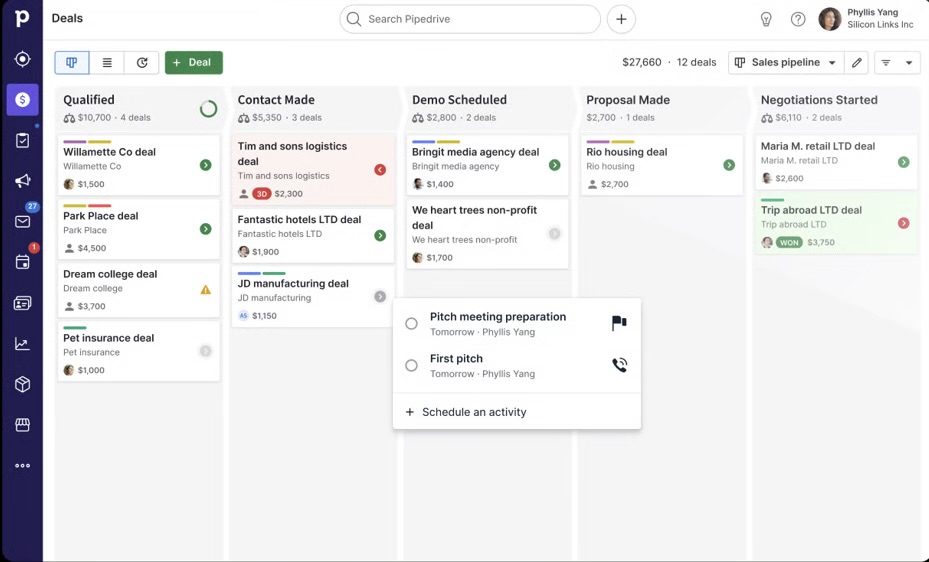
Pipedrive is a sales-first CRM platform built to help you close deals faster.
Its built-in AI Sales Assistant offers real-time suggestions on high-priority deals and next best actions. You can create invoices directly from the deal detail view, and if you have the Products catalog enabled, your invoice auto-fills with product details already added to the deal.
Additionally, it helps monitor your CRM process, set financial goals, and automate reporting with the Insights feature. Since deal-specific insights and financial summaries are embedded into your workflow, you don’t need to switch between tools to stay on top of revenue performance.
Pipedrive best features
- Draft and personalize outreach emails with the AI email generator, tailored to each lead’s behavior and context
- Track invoice statuses in real time through the QuickBooks integration that updates payment information in your CRM
- Summarize client emails instantly using AI to reduce the reading time and respond faster
- Monitor financial performance with deal-specific value fields and visual sales goal tracking
Pipedrive limitations
- No native email marketing, newsletter analytics, or lead capture forms
- Advanced analytics, forecasting, and automation often require upgrades
Pipedrive pricing
- Free trial
- Essential: $19/month per user
- Advanced: $34/month per user
- Premium: $64month per user
- Ultimate: $89/month per user
Pipedrive ratings and reviews
- G2: 4.3/5 (2,500+ reviews)
- Capterra: 4.5/5 (3,000+ reviews)
📮 ClickUp Insight: More than half of employees struggle to find the information they need at work. While only 27% say it’s easy, the rest face some level of difficulty, with 23% finding it very difficult.
When knowledge is scattered across emails, chats, and tools, wasted time adds up fast. With ClickUp, you can turn emails into trackable tasks, link chats to tasks, get answers from AI, and more within a single workspace.
💫 Real Results: Teams are able to reclaim 5+ hours every week using ClickUp—that’s over 250 hours annually per person—by eliminating outdated knowledge management processes. Imagine what your team could create with an extra week of productivity every quarter!
5. FreshBooks (Best for time tracking, expense logging, and invoicing)
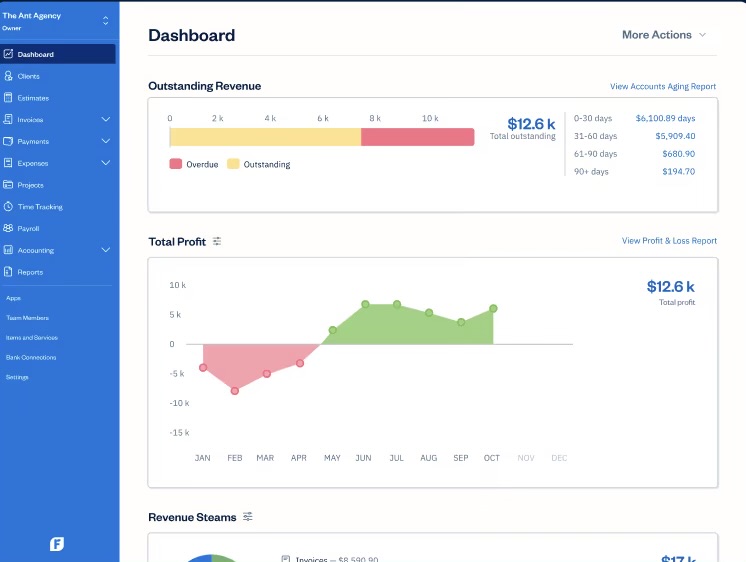
FreshBooks comes with customizable CRM templates, tax-friendly expense categories, and a simple retainer setup. Plus, you can generate detailed client reports focusing on Revenue by Client, Payments Collected, and Retainer Summaries for complete visibility.
Its mobile app and Chrome Timer extension ensure you capture every billable hour, whether you’re working from your desk or on the go.
Beyond being just a time billing software, FreshBooks also functions as a lightweight client management system. It facilitates better collaboration with customer portals, project comments, and file sharing.
The mobile app also provides real-time updates on expenses, time logs, and payments, so you’re always a few taps away from understanding where your business stands.
FreshBooks best features
- Connect your bank or credit card to automatically import, categorize, and update business expenses
- Use automatic receipt scanning to log physical and digital receipts instantly and capture merchant details
- Bill clients for expenses by marking costs as billable and pulling them directly onto invoices with optional markup
- Track client credits and prepayments through the Credits feature and auto-apply them to future invoices
FreshBooks limitations
- Lacks a clear ledger-style interface, making reconciliation less intuitive for some users
- Some users report issues with syncing, duplicate entries, or confusion in feed management
FreshBooks pricing
- Free trial
- Lite: $10.50/month per user
- Plus: $19/month per user
- Premium: $32.50/month per user
- Select: Custom pricing
FreshBooks ratings and reviews
- G2: 4.5/5 (900+ reviews)
- Capterra: 4.5/5 (4,500+ reviews)
What are real-life users saying about FreshBooks?
A quick snippet about this CRM and invoicing software from a user:
💡 Pro Tip: Use freelance templates in ClickUp to instantly generate project proposals, invoices, and client onboarding tasks without any delays.
6. HubSpot (Best for CRM automation, quote creation, and revenue reporting)
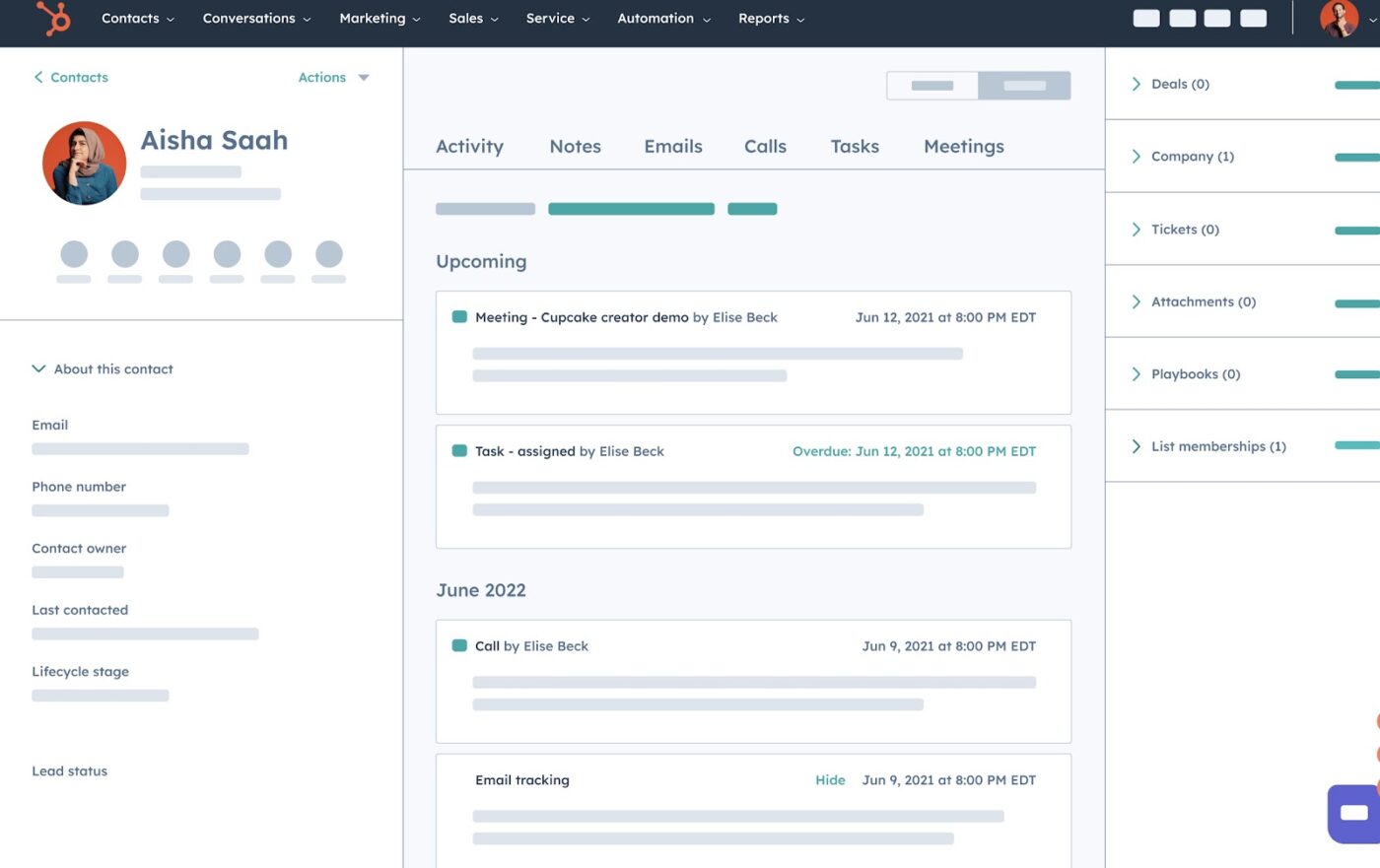
HubSpot connects invoicing with marketing and sales activities, which helps when you want billing integrated into your broader customer journey. Use it to ask for payment with branded digital invoices directly through Stripe or HubSpot Payments.
The automation capabilities enable you to set up workflows that send follow-up emails for overdue invoices without requiring manual intervention. Through QuickBooks integration, you can sync invoice and payment data between HubSpot and your accounting system.
HubSpot also allows you to create invoices directly from deals or quotes, embed payment links, and automatically track what’s been paid or what’s overdue.
HubSpot best features
- Track unpaid invoices and trigger reminders using automation connected to your pipeline
- Ask Breeze Copilot to summarize records, prep for calls, and research companies in seconds
- Create shared invoice templates powered by AI to help your team respond faster and consistently
HubSpot limitations
- Interface elements like pipeline layout or design can’t be tailored deeply without workarounds
- Lacks a dedicated in-house onboarding team; setup often requires third-party support
HubSpot pricing
- Free tools
- Starter Customer Platform: $15/month per user
- Smart CRM Professional: $1450/month for 6 users
- Smart CRM Enterprise: $4,700/month for 8 users
HubSpot ratings and reviews
- G2: 4.4/5 (29,000+ reviews)
- Capterra: 4.5/5 (4,000+ reviews)
🧠 Fun Fact: In the 1950s, the CRM concept began with physical Rolodexes. Invented in 1956 by Danish engineer Hildaur Neilsen, these rotary card files were once the ultimate symbol of a salesperson’s network.
7. Bitrix24 (Best for sales tracking and payment collection)
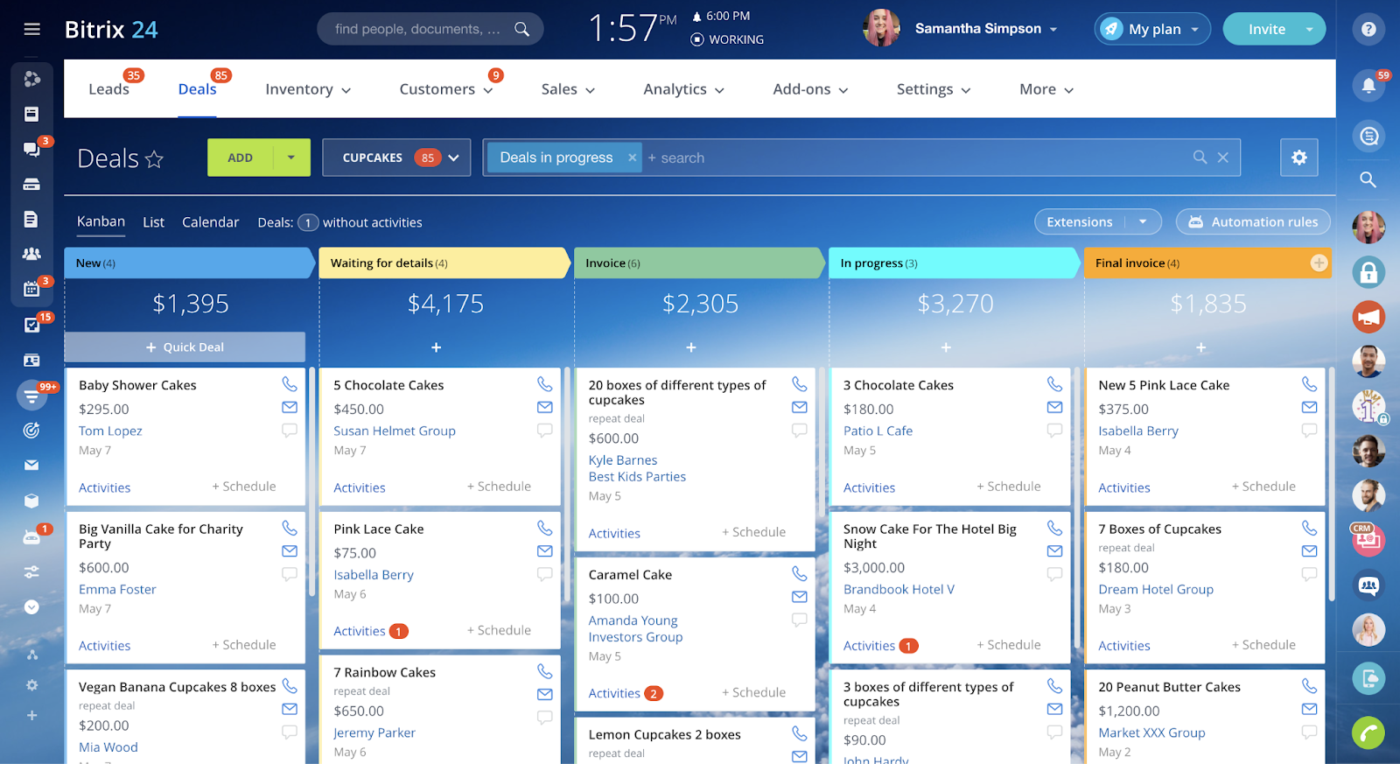
Bitrix24 is designed to help teams streamline communication, project management, CRM, and operations.
If you need to configure required fields, payment systems, and client types in your invoices, this tool is particularly helpful. Plus, you can create templates in different languages for customers from different countries. The invoicing system automatically handles multiple currencies, taxes, and discounts based on the client’s location.
You can integrate with PayPal for payment processing and Xero for accounting synchronization. Once customers approve quotes, you can convert them into invoices with one click.
Bitrix24 best features
- Track sales metrics and performance through BI reports, funnel analytics, and CRM dashboards
- Draft offers, transcribe calls, and bill clients in an intuitive user interface with the AI assistant
- Turn any message into a lead across email, chat, phone, or social via the omnichannel contact center
- Manage product catalogs and taxes with built-in support for multi-currency and localized tax compliance
Bitrix24 limitations
- Only the super admin can make key setting changes, limiting workflow flexibility for general users
- Many basic functions, like clock-in/out and advanced task tools, are locked behind higher-tier plans
Bitrix24 pricing
- Free
- Standard: $124/month (includes 50 users)
- Professional: $249/month (includes 100 users)
- Enterprise: $499/month (includes 250 users)
Bitrix24 ratings and reviews
- G2: 4.1/5 (500+ reviews)
- Capterra: 4.2/5 (900+ reviews)
What are real-life users saying about Bitrix24?
This is how one user described their customer experience:
🚀 The ClickUp Advantage: Ask ClickUp Brain to create tasks for each lead mentioned in a ClickUp Chat thread. It will analyze the conversation and suggest new tasks, which you can add to your workspace with a click.
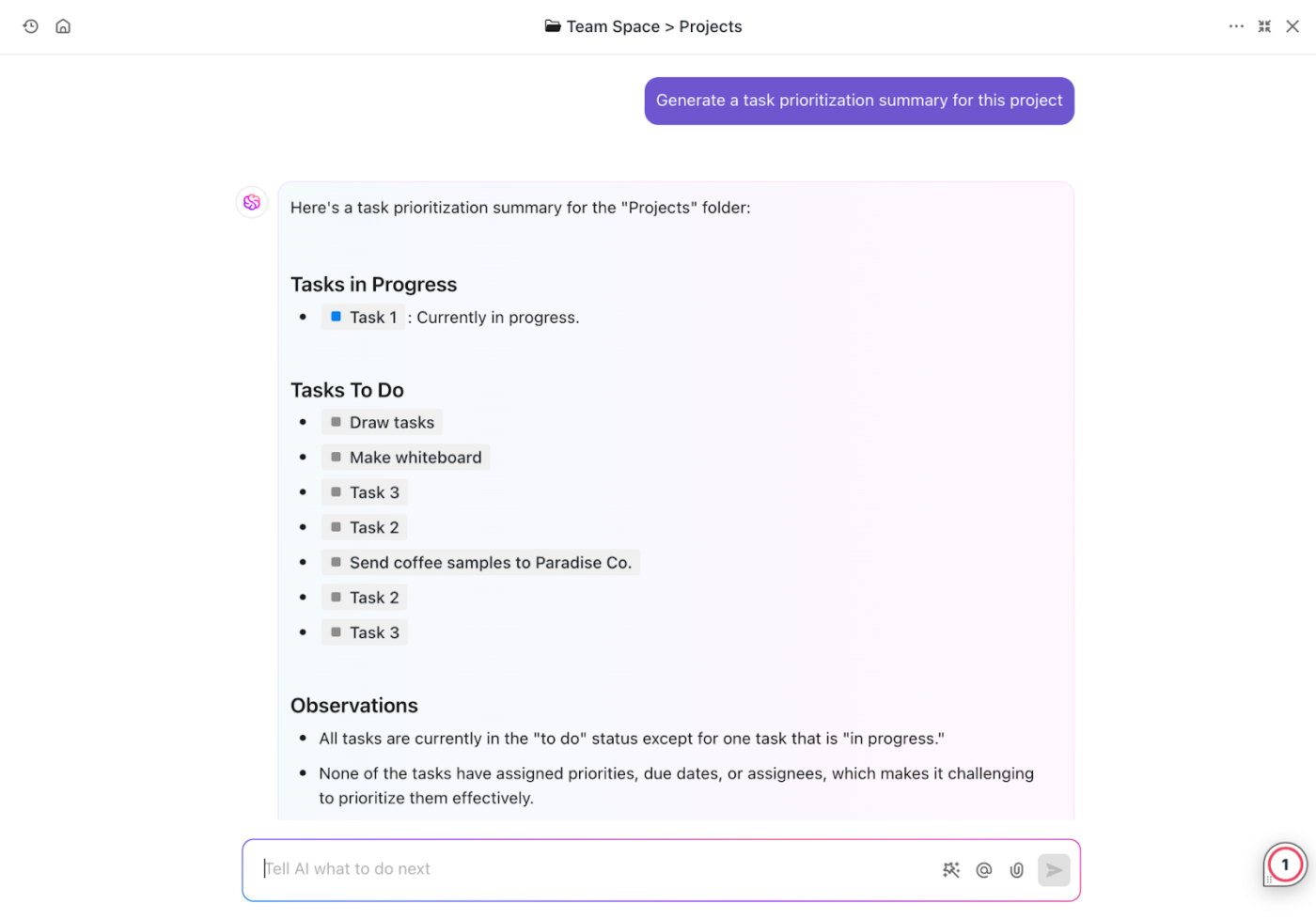
8. Odoo CRM (Best for workflow customization and customer management)

Odoo is a CRM software example that simplifies lead management and speeds up billing with a modular setup built for flexibility.
You can use it to instantly track revenue forecasts, schedule follow-ups, and automate sales activities based on pre-defined scripts. The platform automatically creates all the underlying journal entries for accounting transactions, such as customer invoices, vendor bills, and expenses.
The Invoicing app is ideal for basic billing needs, or you can add the full Accounting app for comprehensive financial reports, bank reconciliation, and asset management. The system includes invoice digitization using OCR and AI technologies to automatically encode paper invoices into digital forms.
Odoo works well when you need invoicing to integrate with inventory, manufacturing, or other business operations.
Odoo CRM best features
- Create personalized sales pipelines with Kanban-style views that show deal value, contact info, and stage in one place
- Automatically schedule next steps like calls, emails, or meetings based on your sales playbook with automation capabilities
- Handle subscriptions and recurring invoices seamlessly using built-in frequency settings and auto-renewals
Odoo CRM limitations
- Complex setup for small teams; too many detailed configurations across domains can feel overwhelming and unnecessary
- Some user workflows aren’t easily editable or flexible without developer help
Odoo CRM pricing
- Free
- Standard: $31.10/month per user
- Custom: $46.80/month per user
Odoo CRM ratings and reviews
- G2: 4.1/5 (140+ reviews)
- Capterra: 4.2/5 (1,200+ reviews)
🔍 Did You Know? Luca Pacioli’s 1494 treatise introduced double-entry bookkeeping, embedding debits and credits into invoicing. This remains the backbone of how invoices work today.
Seal the Deal With ClickUp
Choosing the right CRM and invoicing software means finding a solution that goes beyond tracking financial transactions.
While each tool on this list brings something valuable to the table, ClickUp stands out as the everything app for work that connects your sales, finance, and project teams without the chaos.
With ClickUp’s CRM, you can customize pipelines, automate follow-ups, and manage client communication seamlessly. Pair it with the ClickUp Finance Software to track budgets, streamline recurring payments, and generate smart dashboards that give you a clear picture of cash flow and profits.
Sign up for ClickUp today!

